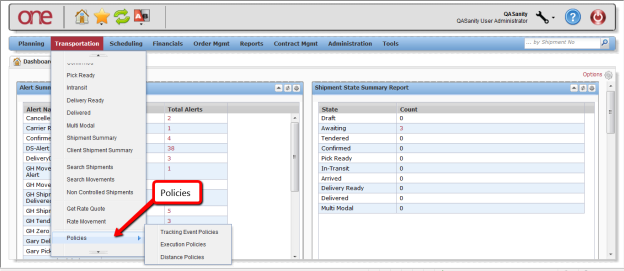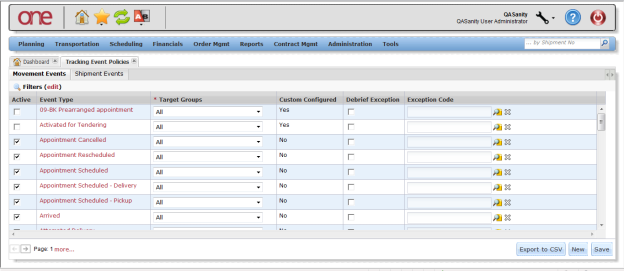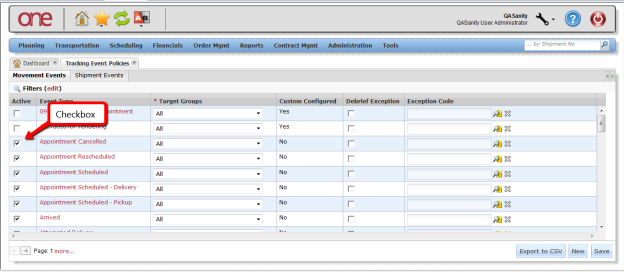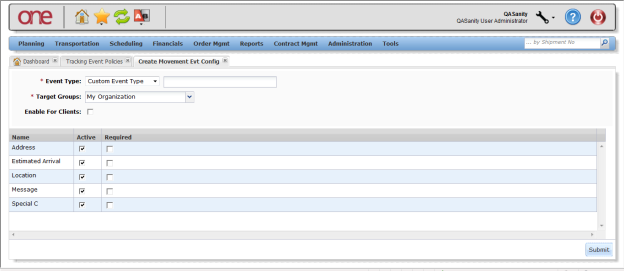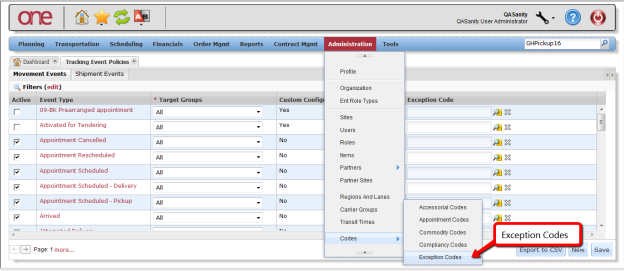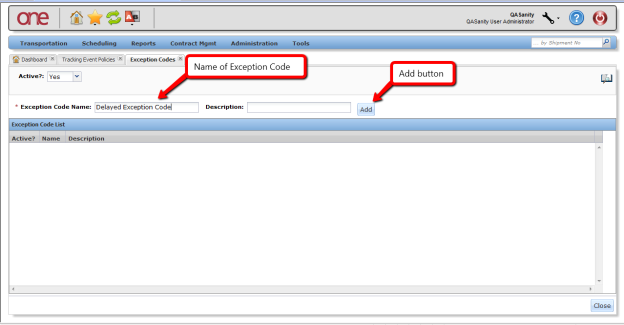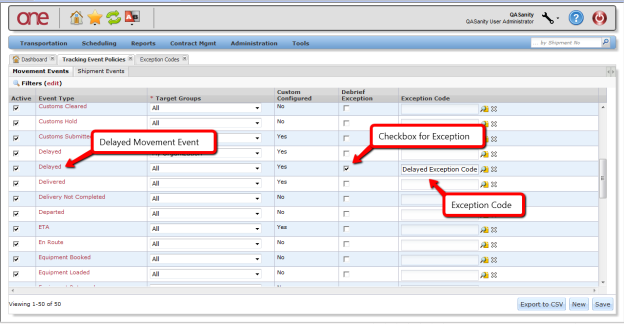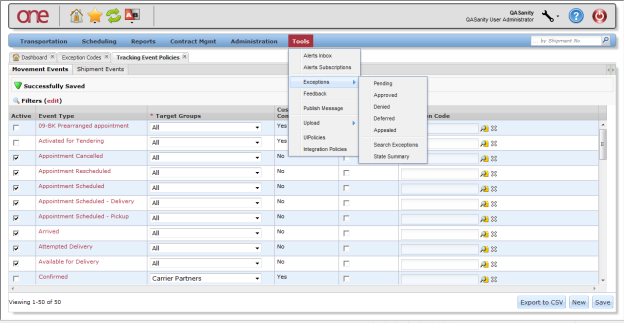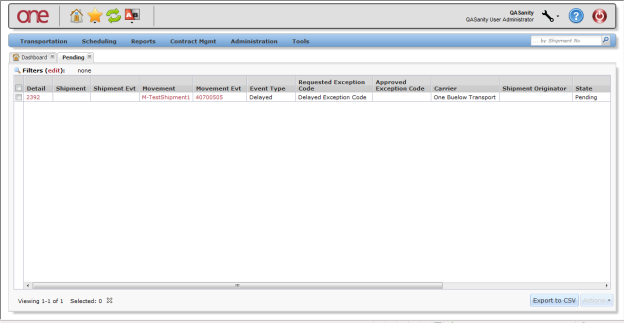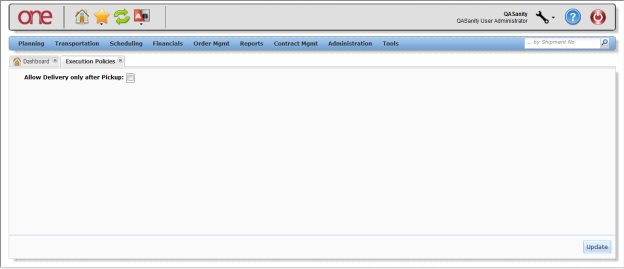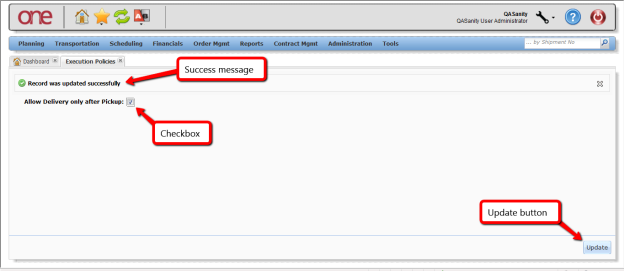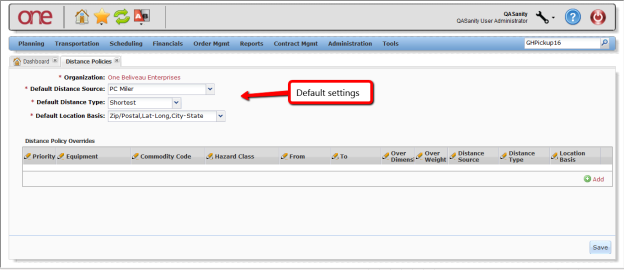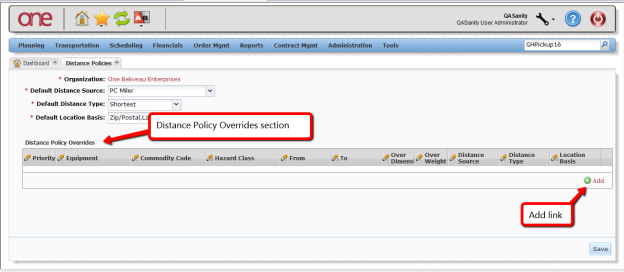...
Configuring Transportation Related Policies
- Log in on to the One Network system.
- Navigate to Transportation > Policies. Three Policies options are available: Tracking Event Policies, Execution Policies, and Distance Policies.
Configuring Tracking Event Policies
- Select Navigate to Transportation > Policies > Tracking Event Policies.
- The Tracking Event Policies page is displayed. There are two tabs at the top of the screen: Movement Events and Shipment Events. The Movement Events tab lists those Tracking Events that would be tracking events that are available at the Movement level, and the Shipment Events tab lists those Tracking Events that would be the tracking events that are available at the Movement level.
To define which Tracking Events that will be displayed display the tracking events in the list of available Tracking Events tracking events at the Movement level and at the Shipment level, set the checkboxes under the Active column by each desired Tracking Eventrequired tracking event.
Note This will be the list of Tracking Events tracking events shown when the user selects the Create Tracking Event button on the Movement Tracking or Shipment Tracking screen.
Info The One Network system comes with a group of pre-defined tracking events.
- Click New, to Tracking Events. To see the list of system-provided tracking events.
- Open Tracking Events, press the New button. On the Create Movement EvtConfig screen page or the Create Shipment Evt Config screen, for page.
From the Event Type
fielddrop-down list, select
theStandard Event Type
option from the drop down list. The.
Info The field next to this will then have a drop down list of the system-provided Tracking Events. When selecting one of these events from the drop down list, the fields for this event will be displayed and if they are required by the system or not.
theIf a field is required by the system, the user cannot make it optional. To configure the field to be displayed or not, select or deselect the check box for that field name under
columnthe Active
column.
Note For a system-provided Tracking Event, the user can define if they want a non-required field to be required by selecting the check box next to that field name under the Required column.
Tracking Event byInfo The user can configure the fields for a
thetracking event by Partner Type. To define the Partner Type, select one of the options from
fieldthe Target Groups
field drop down list.
Info The user can create custom Tracking Events and configure the required and optional fields for different Partners. These custom Tracking Events are meant to be information only and they will not execute any business logic when selecting that event.
To create a custom tracking event,
press theclick New
button.
The
screen will be displayed (Note – if selecting the New button fromInfo The Create Movement Evt Config
thepage is displayed. If you click New from the Shipment tab,
screen will bethe Create Shipment Evt Config
)page is displayed
.
- For From the Event Type field drop-down list, select the Custom Event Type option from the drop-down list, and enter a name for the custom Tracking Event in the text field next to the drop-down list.
- Select an option from the From the Target Groups drop-down list to define who can view and operate on this custom Tracking Eventtracking event. Options include My Organization, Carrier Partners, Customer Partners, Supplier Partners, Carrier and Customer Partners, Carrier and Supplier Partners, Customer and Supplier Partners, All Partners, and All.
- Select the required fields you would like to be displayed for this custom Tracking Event tracking event by selecting clicking the respective check box by the associated field name under the Active column. If you also want a field to be required, select the check box for that field For required fields, click the necessary fields under the Required column.
- Press the
Click Submit
button toto create the
Custom Tracking Eventcustom tracking event.
anNote A Movement or Shipment Tracking Event can be configured to raise
inan Exception Request
Thesein response to that event occurring.
canThese Exception Requests
can then be used by the Transportation Controlling Organization and the Carrier to capture details that justify the deviation from the standard, expected process.
thatInfo Exceptions are events that occur
Carrier would like to requestthe
fromdue to which Carrier requests an exemption
anso that the Carrier is not penalized accordingly. To associate
withan Exception
firstwith a Movement or Shipment event, the user must
ancreate
andan Exception Code
screenand then associate that code with a specific Movement or Shipment Tracking Event under the Tracking Event Policies
associatedpage. Once that Tracking Event is submitted by the Carrier, the
willassociated Exception
that thewill be raised
then view to see if theyto check whether Hub can
Anapprove or deny the Carrier's exception request.
canAn Exception
thrucan go
andthrough various states which include: Pending, Approved, Denied, Deferred,
Carrierand Appealed. Once A
isCarrier Exception
theis raised, it will start in
statethe Pending
thestate. The Hub can approve or deny
whichthe Exception
thewhich will move it to
orthe Approved
stateor Denied
deniedstate. Denied Exceptions can be viewed by the Carrier who can appeal the
–denied Exception
appealed– these
wouldappealed Exceptions
thewould move to
statethe Appealed
arestate. Exceptions
theare viewed by the Carrier on his dashboard using
portletthe Exception Request Summary
theportlet. A Hub can defer looking at
untilthe Exception
deferreduntil a later time – these
woulddeferred Exceptions
thewould be moved to
statethe Deferred
state.
- To create an Exception Code, navigate to Administration - > Codes - > Exception Codes.
- On the Exception Codes screen page, enter the name for the exception in the Exception Code Name field and then press the click Add button.
- To associate an Exception Code with a Tracking Event, navigate to Transportation - > Policies - > Tracking Event Policies.
- To define a Tracking Event to raise an Exception Request when that event occurs, select the checkbox for the Debrief Exception for the specific event and enter the Exception Code under the Exception Code column. Press the Save button to
Click Save to save this setting. This can be defined for a Tracking Event at the Movement level using the related tab or at the Shipment level by using its related tab.
When
an ExceptionInfo When this exception-defined Tracking Event is added by the Carrier,
these Exceptionsan exception will be raised. The Hub can view
-these exceptionsby navigating to Tools
-> Exceptions
view Exceptions> Pending. The Hub can also
-view exceptions by their State by navigating to Tools
-> Exceptions
-> State Summary or by navigating to Tools
-> Exceptions
> Search Exceptions.
ExceptionsInfo For pending
Exception if he is okay with it or he can deny it if he does not agree with it or he canexceptions, the Hub can either approve the
Carrierexception,deny it, or defer it and look at it at a later time. The
Exceptionscarrier has a similar view of these
Exceptionsexceptions and can view
heexceptions that the Hub denied and for denied exceptions,
would thenthe carrier can appeal them. The Hub
can see these exceptions under the Appealed state.
Note The following screen-shot shows a Pending Exception that was raised when the Carrier added a Delayed Tracking Event at the Movement level. Select the link exception number under the Detail column to go to the details of the Exception in order to perform an action.
On the Exception Details screen
asInfo On the Exception Details page, the Hub can select an action such
oras Approve
selecting theor Deny. The Hub can also add a comment that can be viewed by the Carrier by
buttonusing Add
the Comments section and then can save that comment by pressing the Add Comment button onbutton in
screenthe Comments section. To save the comment, click Add Comment, which is at the bottom of the
page.
- After performing you complete one of the actions, the state of the Exception will change accordingly.
Configuring Execution Policies
- Select Transportation -To configure execution policies, click Transportation > Policies - > Execution Policies.
The Execution Policies
screen will bepage is displayed.
screen, there is a Policy named "Info On the
". If setExecution Policies page if you set Allow Delivery only after Pickup
this Policy will enforce that a Pickup,
a pick-up action has to be done on a Movement/Shipment prior to performing a Delivered or Ready for Delivery action.
- To set this Policy, select the checkbox next to the Policy name and then press the Update buttonpolicy, click Allow Delivery only after Pickup check-box and click Update. A success message will be is displayed.
- With this Policy set, if the user then tries to perform a Delivered or Ready for Delivery action prior to having done a Pickup action, the system will display an error message stating "Delivery/Delivery Ready action cannot be performed without Pickup action".
Configuring Distance Policies
- Select Transportation -To configure distance policies, click Transportation > Policies - > Distance Policies.
The Distance Policies
screen will bepage is displayed.
screenInfo The Distance Polices
screenpage allows the user to customize the distance calculations for the system to use based on Shipment/Movement characteristics. For example, the user can add rules to say that all hazardous Shipments should use practical route mileage, even when the default mileage is computed using shortest route.
At the top of the
– thesepage, the default settings are defined
etc.. These are required fields. The fields include: "Default Distance Source" such as "PC Miler" or "Mile Maker", the "Default Distance Type" such as "Practical", "Shortest",
, etcand the "Default Location Basis" such as "City-State, Zip/Postal, Lat-Long"
.
Note PC Miler and Mile Maker are third-party tools that the system uses to calculate postal code-to-postal code distances in the United States, Canada and Mexico.
On the bottom of the screen under theInfo Under the Distance Policy Overrides section, the user can set override settings based on Equipment, Commodity Code, From (Country), To (Country), Hazard Class, Over Dimension (Y/N) and Over Weight (Y/N) and then the corresponding Distance Source, Type and Location Basis.
To create a Distance Policy Override setting, press the click Add link and enter information in each of the desiredrequired, editable fields (Note - these editable fields have .
)Note Editable fields are marked with a pencil symbol
.
Note Not all of these settings need to be entered; the user can leave any setting blank.
e.g.Info For each of these override settings, the user also needs to specify its Priority. Priority Numbers must be unique (
etcfor example, 1, 2, 3,
will use.and so on with 1 being treated as the highest priority). If multiple overrides apply, the system
uses the one with the highest priority. Not all of these settings need to be entered. The user can leave any setting blank.
- Once the information has been is entered, press the click Save button to to save the Default and Override settings.
